Back to Journals » Journal of Pain Research » Volume 16
Research Trends of the Research and Development of Acupuncture and Moxibustion Therapy on Lumbar Disc Herniation: A Bibliometric Analysis
Authors Li YX, Xiong J, Zhang Z, Liao K, Zhou XH, Li J, Xiang J, Xu LL
Received 21 February 2023
Accepted for publication 5 May 2023
Published 31 May 2023 Volume 2023:16 Pages 1835—1853
DOI https://doi.org/10.2147/JPR.S400362
Checked for plagiarism Yes
Review by Single anonymous peer review
Peer reviewer comments 2
Editor who approved publication: Dr Houman Danesh
Yu-Xin Li,1 Jun Xiong,2 Zheng Zhang,2 Kai Liao,2 Xiao-Hong Zhou,2 Jun Li,2 Jie Xiang,2 Ling-Ling Xu2
1Graduate School, Jiangxi University of Chinese Medicine, Nanchang, Jiangxi, People’s Republic of China; 2College of Acupuncture and Massage, Jiangxi University of Chinese Medicine, Nanchang, Jiangxi, People’s Republic of China
Correspondence: Jun Xiong, College of Acupuncture and Massage, Jiangxi University of Chinese Medicine, Nanchang, Jiangxi, 330004, People’s Republic of China, Email [email protected]
Background: Acupuncture and moxibustion has been applied worldwide in the treatment of various pain diseases including lumbar disc herniation (LDH) and other pain, However, there has been no bibliometric analysis on this aspect in the past five years. Therefore, this study was carried out for finding research trends and fronts in this field using Citespace and VOSviewer.
Methods: Publications about acupuncture therapy for LDH were extracted from the Web of Science database and PubMed with an unlimited time frame. A bibliometric analysis and visualization of results was conducted using CiteSpace 6.1.R3 and VOSviewer 1.6.18 on the information of the annual publication, countries, journals, institutions, authors, references, and keywords.
Results: A total of 127 publications were included, and the number of publications had increased noticeably over the past 30 years and reached a peak in the past 3 years. The most productive country with the most publications was China, whose Medical University was the institution with the highest volume of publications. The most productive author was Chen Rixin, while the most-cited author was Kreiner DS. Chinese Acupuncture and Moxibustion was the journal with the most publications, and Spine Journal was the most frequently cited journal. In cited references, an article published in The New England Journal of Medicine by Deyo RA had the most citations and the highest centrality. Of the keywords, the five most frequently used keywords include lumbar disc herniation, acupuncture, low back pain, intervertebral disc displacement, and management.
Conclusion: Acupuncture and moxibustion can help to relieve symptoms in patients. However, this field is in the early stages of development and requires more high-quality research studies and international collaborations. In addition, exploring the effectiveness and mechanism of acupuncture for LDH is the hot trend in the future.
Keywords: acupuncture, lumbar disc herniation, bibliometric analysis, Traditional Chinese Medicine
Introduction
Lumbar disc herniation (LDH) is recognized as a localized displacement of disc material beyond the normal margins of the intervertebral disc space.1 The major signs and symptoms of LDH include: radicular pain, weakness, sensory abnormalities, or numbness in a myotome or dermatomal distribution.1,2 Low back pain costs at least $16 billion each year. And LDH is a low back pain disorder, affecting 1% to 5% of the population each year and bringing a huge economic and medical burden to society.3,4 Surgery for a lumbar herniated disc is an effective method, however, about 60–90% of patients with LDH chose to treat with conservative strategies due to the self-limitation of LDH. Thus, the conservative treatment of patients should be spotlighted.5
Acupuncture and moxibustion therapy, a fundamental part of Traditional Chinese treatment, has been practiced in China from 3000 years ago,6 and is characterized by the insertion of a needle at a particular location on the body to treat diseases.7 It has been applied worldwide in the treatment of various pain diseases including LDH and other pain.8,9 Although the mechanisms of the effectiveness of acupuncture remain undefined, many studies have revealed that acupuncture’s therapeutic has an analgesic effect in clinical practice for LDH.10–13 In addition, from the perspective of medical expenses, it reduces the economic burden of patients.14 Kim et al found that acupuncture and moxibustion can help to relieve pain and improve life quality at low cost,14 but the treatment method of LDH still remains a subject of investigation.
Bibliometric analysis serves as a useful tool to comprehensively evaluate and quantify research progress in a specific field of science,15 which can measure the interrelationships and impacts of publications with mathematical and statistical methods.16 This analytical method has been applied in various research fields, including pain management.16 Numerous studies have demonstrated the acupuncture-induced analgesia for LDH over the past 30 years.17,18 Despite the heat in the clinical and research fields, to our knowledge there is no bibliometric study conducted on the use of acupuncture for LDH. And it is critical to understand the research status of acupuncture treatment of LDH at the overall level, which can help to evaluate the development trends and indicate the potential directions for future research of acupuncture.
CiteSpace and VOSviewer are widely used software tools for constructing bibliometric analysis.19 With the help of visualization tools, bibliometric analysis can detect the status and trends in a specific field through co-occurrence and co-citation analysis of authors, journals, countries, related publications, and their cooperation relationships. And it will be an important clue for future research.19,20
It is important to analyze the research trend of acupuncture and moxibustion therapy for LDH, and CiteSpace and VOSviewer are two major applications. Therefore, this study was designed to explore and visualize the status and research trends of acupuncture and moxibustion treatment for LDH using CiteSpace and VOSviewer software.
Methods
Source of Literature and Search Strategy
All data for this study were extracted from the Web of Science (WoS) Core Collection database and PubMed on December 1, 2022. The data search strategy of WoS was as follows: (TS=(moxibustion OR Acupuncture OR Acupuncture Therapy OR Acupuncture, EAcupuncture Points OR Acupuncture Analgesia)) AND TI=(LDH OR lumbar disc herniation OR lumbar herniated disc lumbar disc protrusion OR lumbar intervertebral disc herniation OR prolapse of lumbar intervertebral OR prolapse of lumbar intervertebral disc OR protrusion of lumbar vertebral disc OR lumbar disc herniation rupture of the lumbar intervertebral disk OR slipped lumbar intervertebral disc OR herniated lumbar disc OR ruptured disc). There were no restrictions placed on time, language, and type of study, but the repeated publications and articles without full text were excluded from this study. The retrieval of PubMed databases was similar to WoS. The specific search strategies are presented in Table 1. All retrieved studies were assessed by two authors (LYX and ZXH) independently. Any disagreement about the eligibility of the studies would be solved by consulting with a third reviewer (XJ). Ultimately, 44 studies unrelated to acupuncture for LDH were excluded, and 127 articles were included in the analysis (Figure 1).
 |
Table 1 The Topic Search Query |
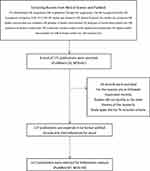 |
Figure 1 Flow diagram of the included study. |
Analysis Tools
We manually removed duplicate and irrelevant data. In the end, we kept 127 records. Citespace 6.1.R3, VOSviewer 1.6.18 and Excel were applied to explore and visualize data for analysis in this research, including: (1) descriptive statistical analysis from publication: for the yearly publication volume, countries, institutions, authors, as well as journals; (2) co-citation network analysis: for authors, journals, and references; (3) co-occurrence analysis of keywords; (4) citation burst analysis: includes references and keywords; and (5) cluster analysis.
The parameters of VOSviewer are set as follows: the minimum number of documents of a source was 1. CiteSpace parameters were set as follows: time slice, 1992–2022; number of years per slice was “1”; source terms, all selection; node type, one at a time; the threshold of “Top N% per slice” was 50; and the method of clustering labels was the LLR algorithm, and pruning (pathfinder).
Chart Interpretation
Different nodes in the maps represent different objects being analyzed, and the size of the node’s diameter represents the frequency. Lines between nodes represent links, which mean the co-occurrences between these two nodes in the same research. The color of the line represents the first collaboration time and the thicker line means stronger connection between the two.
Results
Annual Publications and Trends
A total of 127 publications about acupuncture and moxibustion therapy for LDH were retrieved from the database, with 81 journal articles, 26 articles, and 16 reviews. (Details of type of literatures are shown in Table 2.) The number and trend of published articles in each year are presented in Figure 2. All included studies were published in 1992 or later, and we divided the period from 1992 to 2022 into two stages: 1992 to 2005 was one phase, in which the annual number of articles was growing barely with the total number of publications fewer than 2 each year; 2005 to 2022 was another phase, in which the number of publications increased significantly with fluctuations. The average number of annual publications was more than 5, and peaked in 2020. In summary, the number of publications on an upward trend, and the research fever on acupuncture and moxibustion for LDH could be considered to continue.
 |
Table 2 Document Types for Documents on Acupuncture for LDH |
 |
Figure 2 The number of annual publications on acupuncture and moxibustion for LDH indexed by WoS and PubMed. |
Analysis of Countries/Regions
From 1992 to 2022, a total of 8 countries/regions have made contributions to the publications of LDH treated by acupuncture and moxibustion. CiteSpace was used to visualize the research articles in each country/region (Figure 3 and Table 3). China had the highest output with an absolute superiority (92 publications, 72.44%), followed by South Korea (11 publications, 8.66%) and the United States (8 publications, 6.30%). Furthermore, the country with the most link centrality was the USA (0.10), which might reflect that it had more cooperation with others, and the visual international cooperation network showed that the United States had cooperative relations with China and South Korea. This result suggested that China, South Korea, and the United States played essential roles in research studies of this field. However, networks of international cooperation have not formed among countries.
 |
Table 3 The Top 4 Productive Countries/Regions Concerning Acupuncture for LDH |
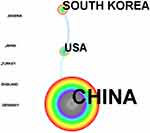 |
Figure 3 Map of active countries/regions on acupuncture and moxibustion for LDH. |
Analysis of Institutions
According to the results of the visualization analysis of institution, 147 institutions were concluded for visualization analysis in this field (Figure 4). The top 5 institutions by number of publications are presented in Table 4. The Jiangxi University of Traditional Chinese Medicine (7 articles) had the largest number of research articles, and the other institutions of the top 5 were the Guangzhou University of Chinese Medicine (5 articles), Anhui University of Traditional Chinese Medicine (5 articles), Kyung Hee University (5 articles), Beijing University of Chinese Medicine (5 articles), and Korea Institute of Oriental Medicine (4 articles). The top 3 institutions in terms of centrality were Jiangxi University of Traditional Chinese Medicine (0.03), Guangzhou University of Chinese Medicine (0.02), and Anhui University of Traditional Chinese Medicine (0.02), which suggested that these institutions had more cooperation than others. However, the centrality of these institutions was relatively low (less than 0.10), indicating that a close cooperative network has not been established. And the network map of institutional cooperation showed the cooperation among domestic institutions was relatively close, however, global cooperation network has yet to be completed. The top 3 institutions by research output were from China, which was consistent with the country or region analysis.
 |
Table 4 Top 5 Institutions Performed Research on Acupuncture for LDH |
 |
Figure 4 Map of institutions on acupuncture and moxibustion for LDH. |
Analysis of Authors and Co-Cited Authors
In total, 322 authors were involved in research on acupuncture and moxibustion in the field of LDH (Figure 5). The top 5 authors are shown in Table 5. Chen Rixin from Jiangxi University of Traditional Chinese Medicine in China was ranked first in this field with 8 articles published, followed by Zhang Bo (6 articles) and Chi Zhenhai (6 articles). However, the network map of author cooperation showed that the cooperation between authors was not close enough since mainly in the same organization.
 |
Table 5 The Top 5 Authors Who Study Acupuncture for LDH |
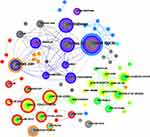 |
Figure 5 Map of authors who study acupuncture and moxibustion for LDH. |
Co-cited authors refer to those with two or more authors or their articles cited simultaneously in a publication. Here, a total of 269 authors were cited in these 127 included researches, which are shown in Figure 6. The top 10 co-cited authors in terms of frequency and centrality are presented in Table 6. Kreiner DS ranked first with the most co-cited frequency (cited 8 times), followed by Chen RX (cited 7 times) and Mother D (cited 6 times). However, Chen RX had the highest centrality, and Mother D, Atlas SJ, Kreiner DS, and Inoue M had relatively high centrality. According to the top 10 authors of citation frequency, there were obvious cooperation networks among scholars from different countries, such as Kreiner DS, Chen RX, and Mother D. In addition, Chen RX published the largest number of articles and citations, who had made a major contribution to the field of acupuncture and moxibustion for LDH.
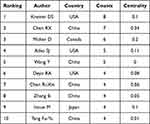 |
Table 6 Top 10 Co-Cited Authors Performed Research on Acupuncture for LDH |
 |
Figure 6 Map of cited authors related to acupuncture and moxibustion for LDH. |
 |
Figure 7 Map of journals producing publications about acupuncture and moxibustion for LDH. |
Analysis of Journals, and Co-Cited Journals
The overall number of 127 articles about acupuncture and moxibustion for LDH were published in 33 journals. As revealed in Table 7 and Figure 7, Chinese Acupuncture & Moxibustion was the most productive journal (53 documents), followed by Medicine (21 documents), and Acupuncture Research (13 documents).
 |
Table 7 The Top 10 Journals Related to Acupuncture on LDH |
A journal co-citation analysis was to determine the journals that had significant influence in a specific field. Figure 8 presents the network map of co-cited journals. Generally, the closer two journals are located to each other, the stronger their correlation. The top 10 co-cited journals are displayed in Table 8. The Spine Journal was most cited with 27 citations, and followed by Chinese Acupuncture and Moxibustion (22 citations), Evidence-based Complementary and Alternative Medicine (19 citations), European Spine Journal (15 citations), and Acupuncture in Medicine (13 citations).
 |
Table 8 The Top 10 Co-Cited Journals on Acupuncture for LDH |
 |
Figure 8 Map of co-cited journals producing publications about acupuncture and moxibustion for LDH. |
Analysis of Co-Cited References
All 239 references were concluded, and the top 5 co-cited references in frequency and centrality are displayed in Table 9. The article published in New England Journal of Medicine by Deyo RA had the highest co-citations (4), followed by the article published in Arthritis Research and Therapy by Cunha C (4), and the article published in Chinese Acupuncture and Moxibustion by Tang Fu-Yu (4), and these articles could be considered as the most influential reference on the acupuncture and moxibustion therapy of LDH. A cluster analysis of co-cited references provided a total of five main clusters (Figures 9–11). The modularity Q was 0.62, and the mean silhouette was 0.87>0.7, demonstrating that the results of a cluster were credible. The results illustrated that most research studies in this area were carried out after 2010. Main research directions at early stage were Cluster 2 “manual acupuncture” and Cluster 3 “herniated intervertebral disc” with first publication before 2013. These were followed by Cluster 8 “Intervertebral disc displacement”, which mainly represented studies conducted between 2014 and 2017. Finally, Cluster 1 “therapeutic effect” was a long-standing research direction in this field and continued to the present. Presented below is specific information about each cluster.
 |
Table 9 Top 5 Co-Cited References Related to Acupuncture for LDH |
 |
Figure 9 Map of co-cited references related to acupuncture and moxibustion for LDH. |
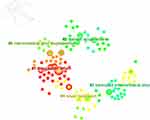 |
Figure 10 Map of co-citation cluster analysis related to acupuncture and moxibustion for LDH. |
 |
Figure 11 Timeline map of references on acupuncture and moxibustion therapy for LDH. |
Articles included in Cluster 2 “manual acupuncture” evaluated the efficacy to manual acupuncture treatment for LDH, but generally favor positive outcomes. Articles in Cluster 3 “herniated intervertebral disc” evaluated the efficacy to different interventions for LDH, such as epidural corticosteroid injections, traditional acupuncture, and scalp acupuncture stimulation. Those in Cluster 4 “low back pain” primarily described all aspects of lumbar disc herniation, including pathological basis, imaging characteristics, and treatment means. Articles in Cluster 1 “therapeutic effect” primarily evaluated factors associated with lumbar disc herniation and comprehensive plan of diagnosis and treatment. The researchers found that genetic variants in the promoter regions of the IL-6 and IL-10 genes were associated with lumbar disc herniation risk in a Chinese Han population,22 and 5-HT receptors and mesenchymal stem cells delivering via miR-21 have potential therapeutic implications.23 Research in Cluster 8 “Intervertebral disc displacement” demonstrated pain measurement tools and the postoperative prognosis of intervertebral disc displacement.
Table 9 shows the top 5 most frequently and centrality references. Among the 5 studies, two references focused on the clinical practice of lumbar disc herniation, one investigated the mechanisms of lumbar disc herniation, one study evaluated the effects of diverse moxibustion sites on LDH, and a study assessed effects of different conservative therapies.
Figure 12 displays the top 15 references with strongest citation burst. The article with the highest-cited outbreak was a randomized controlled trial published by Tang Fu-Yu (2009), and demonstrated that heat-sensitive moxibustion was effective for lumbar disc herniation, with low recurrence rate and stable therapeutic effect. In addition, Cunha (2018) published an article with high citation bursts, which gives a special focus on the inflammatory response in the scope of the clinical decision on conservative versus surgical intervention of LDH, and might indicate that the inflammatory response in the treatment with LDH patients is a potential major research direction.
 |
Figure 12 Top 15 references with the strongest citation bursts. |
Analysis of Keywords
The top 10 co-occurrence keywords in terms of frequency and centrality can be seen from the Table 10 and Figure 13. The 5 most frequently used keywords were lumbar disc herniation (25), followed by acupuncture (12), low back pain (12), intervertebral disc displacement (8), and management (7). This indicated that verifying whether acupuncture can manage the lumbar disc herniation remains a focus of research in this field. And the keyword with highest centrality was lumbar disc herniation (0.75), followed by acupuncture (0.2), low back pain (0.2), diagnosis (0.16), and systematic review (0.1). All 154 keywords from the 127 publications were classified into 7 clusters(Figure 14), including “pain”, “lumbar herniated intervertebral disc”, “systematic review”, “acupotomy”, “ankle acupuncture”, “prospective studies”, “symmetrical index of spinal column”, and “clinical trials”. The timeline view is used in Figure 15 to show the evolution timeline of keywords.
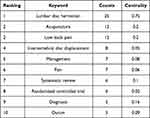 |
Table 10 Top 10 Co-Occurrence Keywords Related to Acupuncture for LDH Research |
 |
Figure 13 Map of co-occurrence keywords related to acupuncture and moxibustion for LDH. |
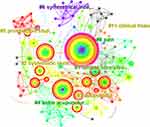 |
Figure 14 Cluster map of co-occurrence keywords related to acupuncture and moxibustion for LDH. |
 |
Figure 15 Timeline view of keywords about acupuncture and moxibustion for LDH. |
“Burst words” refers to keywords that are frequently used in a given time period and represent the research hot spot. As Figure 16 shows, keywords with the strongest citation bursts first appeared in 2012. The top 5 burst keywords were “acupuncture”, “Korean version”, “surgery”, “validation”, and “stimulation”. The result showed that acupuncture and moxibustion treatment of LDH still mainly focused on clinical trials. “outcm” from 2019 and “management” from 2020 are the latest burst keywords, and have been still ongoing. This showed the development of the management and treatment for LDH.
 |
Figure 16 Top 15 keywords with the strongest citation bursts. |
Discussion
Development in the Trend of Annual Publication Volume
In this study, 127 research studies between 1992 and 2022 were included by using a bibliometric tool to analyze research trends on acupuncture and moxibustion for LDH. Analysis of the annual publications and trends revealed an overall increasing trend. This increase was not apparent at an early stage, while it became more prominent after 2005 that indicated that this field was in a development phase with great scope for research value.
High Impact Institutions, Countries, and Scholars in the Fields of Acupuncture and Moxibustion on LDH
China, South Korea, and the United States had the highest numbers of publications and made the most prominent contributions. However, by the bibliometric analysis of countries/regions, we found that there was weak cooperation with other countries and networks of international cooperation had not formed. China and Korea institutions were the main sites for research in this area, and the main forms were medical schools and their affiliated medical hospitals. In addition, the highest output came from China, which meant it had made a great contribution in this field. None of the institutions in the rank centrality had a value exceeding 0.10, indicating that the network of institutional cooperation had not yet formed, and there were only small-scale cooperations among institutions. Therefore, the global collaboration required encouragement.
From China, Chen Rixin and his research team had the most publications, focusing on the effect of heat-sensitive moxibustion among patients with LDH, which also promoted the rapid development of moxibustion. Kreiner DS and his partners were the most influential scholars being cited 8 times. An evidence-based clinical guideline provided a reference for the diagnosis and treatment of lumbar disc herniation with radiculopathy.1
Analysis of Hot Trends of Acupuncture and Moxibustion Treatment on LDH
Analysis of the Therapeutic Effect of Acupuncture and Moxibustion on LDH
Acupuncture and moxibustion has been applied in the treatment of various pain disease.8 “Acupuncture’s Role in Solving the Opioid Epidemic” white paper showed the evidence of positive effect and conditions with demonstrating evidence of cost-effectiveness about acupuncture on low back pain.24 Based on the top 5 burst keywords, it could be confirmed that the study on the efficacy of acupuncture and moxibustion in treating LDH is still the field research hot spot and focus.
Hot Research Topics and Directions
Based on the clustering and burst keywords, the largest cluster was “pain” with persistence of high attention. Of the 15 burst keywords, “pain” had the greatest intensity of burstiness. Pain is a common symptom of LDH and commonly treated using opioid analgesics. However, the high use of opioids contributed to a growing number of opioid-related deaths from addiction and overdose.24 Acupuncture and moxibustion, as safely and effectively managing pain, have caught the attention of researchers. A meta-analysis determined that the effect of Needle-Warming Moxibustion on LDH was superior to other conservative therapy, and the VAS of LDH patients was lower. A hot direction of research arising from this research focus is “surgery”. Surgical treatment is an effective method for patients with LDH, shown to provide significantly faster pain relief than conservative management, although the effect fades after one year.25 A study by Sokunbi demonstrated that acupuncture therapy with the combination of treadmill walking exercises and core-stability exercises were useful in treating patients with postoperative lumbar disc herniation.26
Key Research Trends
On the whole perspective, burst keywords appeared in the first 5 years mainly concentrated on discussion about acupuncture and moxibustion analgesic technology, and the main research form was a randomized controlled trial. In the last 5 years, the focus has been on pain management and the mechanism of acupuncture and moxibustion analgesia, with the number of systematic reviews has gradually increased (as can be seen through cluster analysis). Moreover, acupoint thread-embedding also has its place, as evidenced by the burst keyword “thread-embedding acupuncture” and the latest burst keywords “polydioxanone” (a material for acupoint thread-embedding).
The citation status of references also showed distinct characteristics of evidence-based medicine. Although the types of the most influential literatures in this field were diverse, they were mainly based on the reviews of randomized controlled trials and clinical trials. According to the clustering results, both “#2 systematic review” and “#11 clinical trials” had large relative size. The most frequently cited reference was a review published in 2016,27 which suggested that there was insufficient evidence to recommend acupuncture for sciatica. However, the most frequently cited clinical trials that published in 2018 have shown that moxibustion does have an effectiveness on LDH with stable therapeutic effect and low recurrence rate.
According to the top 3 burst references, heat sensitive moxibustion could relieve symptoms on LDH with stable therapeutic effect and low recurrence rate. The latest 5 years of burst references primarily focused on the efficacy of conservative treatment. Hyun-ji Kim et al28 demonstrated that acupotomy combined with Korean medicine could alleviate pain without adverse effects. This fitted with the research direction reflected by the keywords. However, the efficacy of acupuncture and moxibustion therapies remained controversial, and there was insufficient evidence to make a recommendation regarding acupuncture and moxibustion for LDH. In summary, there is controversy regarding the effects of acupuncture for LDH and more high-quality clinical studies are needed in the future.
Limitations
There were some limitations in the current research. Firstly, we mainly included studies published in English and Chinese, however, due to the development of acupuncture research, most of the included studies were published in Chinese. In addition, we searched the articles from WoS and PubMed, and we may have neglected sight of articles were not published in the two databases, in other languages and included in other databases. However, the WoS database is the most commonly used database for bibliometric analysis, and we believed that this research could be representative of the overall situation and trend of the “acupuncture for LDH”.
Conclusion
This field is at an early development stage with great potential. Further high-quality research studies and more international collaborations are needed to better verify the efficacy of acupuncture in treating various clinical symptoms of LDH.
Abbreviations
WoS, Web of Science; RCT, randomized controlled trial; LDH, lumbar disc herniation; IF, impact factor.
Data Sharing Statement
Raw data are obtained directly from the Web of Science Core Collection (WoSCC) and PubMed.
Research Ethics
These data are downloaded from the Web of Science and PubMed databases; these are secondary data and do not involve interactions with animals or humans.
Acknowledgments
The authors would like to express their appreciation to Professor Chen Chaomei, who developed CiteSpace and opening its access.
Author Contributions
All authors contributed to conception and design, execution, data acquisition, analysis, and interpretation; participated in drafting or revising the article; have agreed on the journal to which the article will be submitted; gave final approval for the version to be published and agree to be responsible for all aspects of the work.
Funding
This study was supported by The Youth Foundation Key Projects of Jiangxi Province (20192ACB21007); Jiangxi Province Introduction and Cultures Innovative and Entrepreneurial High level Talent Projects (No. jxsq2019201104).
Disclosure
The authors declare that there are no conflicts of interest in this work.
References
1. Kreiner DS, Hwang SW, Easa JE, et al; North American Spine Society. An evidence-based clinical guideline for the diagnosis and treatment of lumbar disc herniation with radiculopathy. Spine J. 2014;14(1):180–191. PMID: 24239490. doi:10.1016/j.spinee.2013.08.003
2. Benzakour T, Igoumenou V, Mavrogenis AF, Benzakour A. Current concepts for lumbar disc herniation. Int Orthop. 2019;43(4):841–851. PMID: 30506088. doi:10.1007/s00264-018-4247-6
3. Frymoyer JW. Back pain and sciatica. N Engl J Med. 1988;318(5):291–300. PMID: 2961994. doi:10.1056/NEJM198802043180506
4. Arts MP, Kuršumović A, Miller LE, et al. Comparison of treatments for lumbar disc herniation: systematic review with network meta-analysis. Medicine. 2019;98(7):e14410. PMID: 30762743; PMCID: PMC6408089. doi:10.1097/MD.0000000000014410
5. Chen BL, Guo JB, Zhang HW, et al. Surgical versus non-operative treatment for lumbar disc herniation: a systematic review and meta-analysis. Clin Rehabil. 2018;32(2):146–160. PMID: 28715939. doi:10.1177/0269215517719952
6. Zhuang Y, Xing JJ, Li J, Zeng BY, Liang FR. History of acupuncture research. Int Rev Neurobiol. 2013;111:1–23. PMID: 24215915. doi:10.1016/B978-0-12-411545-3.00001-8
7. Chae Y, Olausson H. The role of touch in acupuncture treatment. Acupunct Med. 2017;35(2):148–152. PMID: 28151404. doi:10.1136/acupmed-2016-011178
8. Chon TY, Lee MC. Acupuncture. Mayo Clin Proc. 2013;88(10):1141–1146. doi:10.1016/j.mayocp.2013.06.009
9. Hao JJ, Mittelman M. Acupuncture: past, present, and future. Glob Adv Health Med. 2014;3(4):6–8. doi:10.7453/gahmj.2014.042
10. Zhong RF, Yin XH, Cao YH, et al. 不同时间间隔针刺治疗腰椎间盘突出症的疗效对比 [Efficacy comparision of lumbar disc herniation treated with acupuncture at different time intervals]. Zhongguo Zhen Jiu. 2019;39(5):457–461. PMID: 31099213. Chinese. doi:10.13703/j.0255-2930.2019.05.001
11. Wu Y, Sun Y, Zhang J, Li Y, Wang C. 督穴导气针法”联合电针治疗血瘀型轻中度腰椎间盘突出症临床研究 [Clinical research of mild and moderate lumbar disc herniation of blood stagnation syndrome treated with qi-conducting needling technique at the governor vessel acupoints combined with electroacupuncture]. Zhongguo Zhen Jiu. 2017;37(5):467–472. PMID: 29231605. Chinese. doi:10.13703/j.0255-2930.2017.05.004
12. Wang YL. 不同针刺治疗方法对腰椎间盘突出症的疗效观察 [Observation on the therapeutic effect of lumbar disc herniation treated with different acupuncture therapies]. Zhongguo Zhen Jiu. 2013;33(7):605–608. PMID: 24032192. Chinese.
13. Ma S, Ma J, Pan JN, Zhang XS. 针刺与铺灸疗法治疗腰椎间盘突出症对比研究 [Comparative research of lumbar disc herniation treated with acupuncture and snake moxibustion]. Zhongguo Zhen Jiu. 2010;30(7):563–566. PMID: 20862939. Chinese.
14. Kim SY, Lee H, Lee H, et al. An observational study on the costs and consequences of acupuncture for the management of chronic low back pain in Korean patients. Acupunct Med. 2015;33(2):148–153. doi:10.1136/acupmed-2014-010641
15. Liu Y, Huang L, Xu G, et al. The application of acupuncture therapy for postoperative pain over the past 20 years: a bibliometric analysis. J Pain Res. 2022;15:2085–2104. PMID: 35923845; PMCID: PMC9343020. doi:10.2147/JPR.S371399
16. Pan H, Xi Z, Yu X, Sun X, Wei X, Wang K. Knowledge mapping analysis of international research on acupuncture for low back pain using bibliometrics. J Pain Res. 2021;14:3733–3746. PMID: 34916841; PMCID: PMC8667198. doi:10.2147/JPR.S340992
17. Tang S, Mo Z, Zhang R. Acupuncture for lumbar disc herniation: a systematic review and meta-analysis. Acupunct Med. 2018;36(2):62–70. PMID: 29496679. doi:10.1136/acupmed-2016-011332
18. Huang CY, Lu Y, Sun SN, Zhuang LX, Chen XL. [Clinical efficacy and safety of heat-sensitive moxibustion therapy for lumbar disc herniation: a meta-analysis]. Zhen Ci Yan Jiu. 2016;41(3):255–264. PMID: 29071916. Chinese.
19. van Eck NJ, Waltman L. Citation-based clustering of publications using CitNetExplorer and VOSviewer. Scientometrics. 2017;111(2):1053–1070. PMID: 28490825; PMCID: PMC5400793. doi:10.1007/s11192-017-2300-7
20. Synnestvedt MB, Chen C, Holmes JH. CiteSpace II: visualization and knowledge discovery in bibliographic databases. AMIA Annu Symp Proc. 2005;2005:724–728. PMID: 16779135; PMCID: PMC1560567.
21. Wu MQ. [Clinical observation on selection of acupoints on the same nerve segment for treatment of prolapxe of lumber intervertebral disc]. Zhongguo Zhen Jiu. 2007;27(7):497–499. PMID: 17722827. Chinese.
22. Huang X, Chen F, Zhao J, et al. Interleukin 6 (IL-6) and IL-10 Promoter region polymorphisms are associated with risk of lumbar disc herniation in a Northern Chinese Han population. Genet Test Mol Biomarkers. 2017;21(1):17–23. PMID: 27828714. doi:10.1089/gtmb.2016.0189
23. Kanayama M, Hashimoto T, Shigenobu K, Oha F, Yamane S. New treatment of lumbar disc herniation involving 5-hydroxytryptamine2A receptor inhibitor: a randomized controlled trial. J Neurosurg Spine. 2005;2(4):441–446. PMID: 15871484. doi:10.3171/spi.2005.2.4.0441
24. Fan AY, Miller DW, Bolash B, et al. Acupuncture’s role in solving the opioid epidemic: evidence, cost-effectiveness, and care availability for acupuncture as a primary, non-pharmacologic method for pain relief and management–white paper 2017. J Integr Med. 2017;15(6):411–425. doi:10.1016/s2095-4964(17)60378-9
25. Delgado-López PD, Rodríguez-Salazar A, Martín-Alonso J, Martín-Velasco V. Hernia discal lumbar: historia natural, papel de la exploración, timing de la cirugía, opciones de tratamiento y conflicto de intereses [Lumbar disc herniation: natural history, role of physical examination, timing of surgery, treatment options and conflicts of interests]. Neurocirugia. 2017;28(3):124–134. PMID: 28130015. Spanish. doi:10.1016/j.neucir.2016.11.004
26. Ganiyu SO, Gujba KF. Effects of acupuncture, core-stability exercises, and treadmill walking exercises in treating a patient with postsurgical lumbar disc herniation: a clinical case report. J Acupunct Meridian Stud. 2015;1:48–52. PMID: 25660445. doi:10.1016/j.jams.2014.08.002
27. Deyo RA, Mirza SK, Solomon CG. Clinical Practice. Herniated lumbar intervertebral disk. N Engl J Med. 2016;374(18):1763–1772. PMID: 27144851. doi:10.1056/NEJMcp1512658
28. Kim HJ, Jeon JH, Kim YI. Clinical effect of acupotomy combined with Korean medicine: a case series of a herniated intervertebral disc. J Acupunct Meridian Stud. 2016;9(1):31–41. PMID: 26896075. doi:10.1016/j.jams.2015.09.001
 © 2023 The Author(s). This work is published and licensed by Dove Medical Press Limited. The
full terms of this license are available at https://www.dovepress.com/terms.php
and incorporate the Creative Commons Attribution
- Non Commercial (unported, v3.0) License.
By accessing the work you hereby accept the Terms. Non-commercial uses of the work are permitted
without any further permission from Dove Medical Press Limited, provided the work is properly
attributed. For permission for commercial use of this work, please see paragraphs 4.2 and 5 of our Terms.
© 2023 The Author(s). This work is published and licensed by Dove Medical Press Limited. The
full terms of this license are available at https://www.dovepress.com/terms.php
and incorporate the Creative Commons Attribution
- Non Commercial (unported, v3.0) License.
By accessing the work you hereby accept the Terms. Non-commercial uses of the work are permitted
without any further permission from Dove Medical Press Limited, provided the work is properly
attributed. For permission for commercial use of this work, please see paragraphs 4.2 and 5 of our Terms.
Recommended articles
Knowledge Mapping of Acupuncture for Fibromyalgia from 1990 to 2022: A Bibliometric Analysis
Li P, Zheng H, Chen Y, Liu Z, He J
Journal of Pain Research 2022, 15:2405-2426
Published Date: 18 August 2022
Knowledge Mapping of International Research on Acupuncture for Chronic Pain: A Bibliometric Analysis

Jiao H, Ding R, Jin P, Wang J, Xu J, Tian W
Journal of Pain Research 2022, 15:3711-3728
Published Date: 2 December 2022
Application of Acupuncture for Shoulder Pain Over the Past 22 Years: A Bibliometric Analysis
Chen YL, Liang YD, Guo KF, Huang Z, Feng WQ
Journal of Pain Research 2023, 16:893-909
Published Date: 14 March 2023
Research Trends of Acupuncture Therapy on Myofascial Pain Syndrome from 2000 to 2022: A Bibliometric Analysis
Lu F, Ren P, Zhang Q, Shao X
Journal of Pain Research 2023, 16:1025-1038
Published Date: 21 March 2023
Global Trends and Performances of Acupuncture Therapy on Bell’s Palsy from 2000 to 2023: A Bibliometric Analysis
Yu G, Luo S, Zhu C, Chen L, Huang H, Nie B, Gu J, Liu J
Journal of Pain Research 2023, 16:2155-2169
Published Date: 26 June 2023
